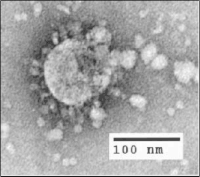
Photo from wikipedia
Besides the intrinsic complications caused by SARS-CoV-2 infection, other conditions, such as bacterial infections pose an additional risk to COVID-19 patients. The study published in this issue by Moreno-Torres et… Click to show full abstract
Besides the intrinsic complications caused by SARS-CoV-2 infection, other conditions, such as bacterial infections pose an additional risk to COVID-19 patients. The study published in this issue by Moreno-Torres et al. [1] assessed the rate and predictors of bacterial infections in patients consecutively admitted with COVID-19 to a tertiary hospital in Madrid, Spain, during the first wave of COVID-19. Among 1594 hospitalized patients with COVID-19, 135 (8.5%) experienced bacterial infectious events, distributed as follows: urinary tract infections (32.6%), bacteremia (31.9%), pneumonia (31.8%), intra-abdominal infections (6.7%) and skin and soft tissue infections (6.7%). Independent predictors of bacterial infections were older age, neurological disease, prior immunosuppression, and admission to intensive care units (ICU). The mortality rate was significantly higher in COVID19 patients with bacterial infections than in the rest (25% vs 6.7%, respectively; p < 0.001). However, in multivariate analysis, older age, prior neurological or kidney disease, immunosuppression and acute respiratory distress syndrome (ARDS) were associated with increased mortality (p < 0.05), while bacterial infections were not. On the other hand, the use of steroids or steroids plus tocilizumab did not confer a higher risk of bacterial infections while increased survival rates. In summary, the authors concluded that baseline COVID-19 severity rather than incident bacterial infections contributed to mortality. Thus, rather than considering empiric antibiotic therapy, the use of steroids or steroids plus tocilizumab might improve survival in this population. From a physio-pathological standpoint, two consecutive phases can be distinguished during acute SARS-CoV-2 infection. The first extends for 7–10 days and results from viral replication in the upper respiratory tract alongside with influenza-like symptoms, such as cough, fever, headache and myalgia. The second phase results from the host immune response mostly in the lungs around 10–14 days later [2]. The presence of lung interstitial infiltrates in image testing at this stage is very common. The severity of hypoxemia reflects the extent of the alveolar inflammatory reaction. In older individuals, the immune response is more prone to be dysfunctional, accompanied by a cytokine release syndrome (‘cytokine storm’) that can be life-threatening. According to this stratification into two phases for COVID-19, antiviral strategies have been postulated for content the first phase, whereas anti-inflammatory agents have been recommended to ameliorate the second phase. Antiviral molecules such as remdesivir or specific monoclonal antibodies have been tested with limited success [3]. Steroids, namely dexamethasone, have shown to reduce the severity of SARS-CoV-2 pneumonitis and improve survival. Indeed, they are the cornerstone of treatment for moderateto-severe COVID-19. Data regarding the rate of superinfections in COVID-19 patients remain scarce, despite the relevance of using efficacious therapies for these conditions, as well as the potential impact of antimicrobial treatments on survival in this population. Retrospective data from several cohorts estimate the incidence of bacterial superinfections between 5 and 27% or 13.5–44% in COVID-19 patients requiring ICU admission [4]. These studies concur to highlight that respiratory and urinary infections are the most frequent bacterial co-infections in COVID-19 patients. Arguably, admission to ICU is associated with other, more complex infections, such as ventilator-associated pneumonia and bloodstream or urinary tract infections [5]. Furthermore, nosocomial infections tend to be associated with more resistant bacterial strains, including C. difficile [6], requiring the use of broad-spectrum antibiotics, which pose additional challenges. Outside ICUs, the * Vicente Soriano [email protected]
Journal Title: Internal and Emergency Medicine
Year Published: 2022
Link to full text (if available)
Share on Social Media: Sign Up to like & get
recommendations!